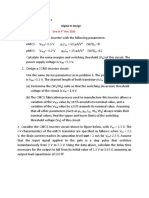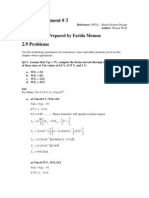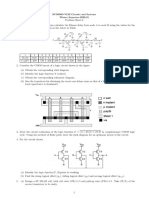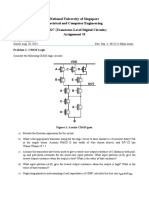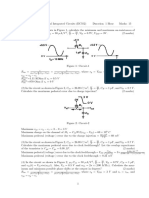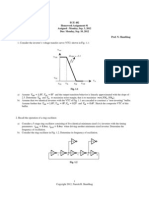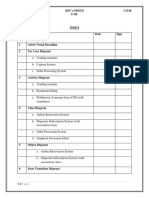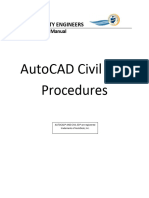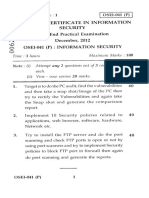0% found this document useful (0 votes)
297 views2 pagesCG2027 - Assign - 1 - Solution
The document is an assignment solution for a digital circuits course. It contains the solutions to two problems:
1) Calculating timing parameters like rise time, fall time, and propagation delays for a CMOS inverter based on a given waveform. The rise time is found to be 23.92 ps, fall time 19.01 ps, and propagation delays 12.26 ps and 13.30 ps.
2) Calculating noise margin high and low for an inverter chain. The noise margin high is 0.10 V and noise margin low is 0.15 V. If the input high and low of the second buffer are the same, it would maximize the noise margins.
Uploaded by
Peng FeiCopyright
© © All Rights Reserved
We take content rights seriously. If you suspect this is your content, claim it here.
Available Formats
Download as PDF, TXT or read online on Scribd
0% found this document useful (0 votes)
297 views2 pagesCG2027 - Assign - 1 - Solution
The document is an assignment solution for a digital circuits course. It contains the solutions to two problems:
1) Calculating timing parameters like rise time, fall time, and propagation delays for a CMOS inverter based on a given waveform. The rise time is found to be 23.92 ps, fall time 19.01 ps, and propagation delays 12.26 ps and 13.30 ps.
2) Calculating noise margin high and low for an inverter chain. The noise margin high is 0.10 V and noise margin low is 0.15 V. If the input high and low of the second buffer are the same, it would maximize the noise margins.
Uploaded by
Peng FeiCopyright
© © All Rights Reserved
We take content rights seriously. If you suspect this is your content, claim it here.
Available Formats
Download as PDF, TXT or read online on Scribd
/ 2







